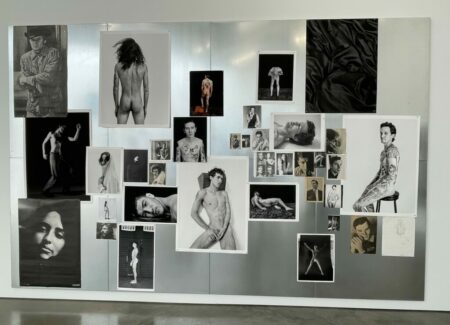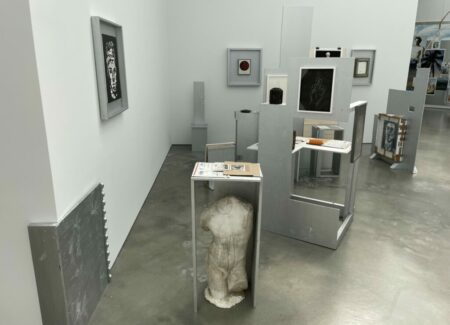JTF (just the facts): A broad survey show of works in various mediums, installed against white walls in the X-divided gallery space and an additional back room.
The photographic works on view include:
- 19 pigment prints, 1986/2022, 2015/2023, 2017, 2020, 2021, 2022, sized 20×15, 30×20, 34×62, 40×30, 60×40, 62×62, 80×60 inches, in editions of 3
- 2 folded pigment prints, 2023, sized 60×80 (or the reverse) inches, in editions of 3
- 1 c-print, 1990, sized roughly 29×19 inches, unique
- 1 Ektacolor print, 1991, sized 30×30 inches, in an edition of 3+1AP
- 1 painting with paper collages on canvas, 1992, sized 68×56 inches, unique
- 3 arrays of archival pigment prints, c-type prints, cylindrical magnets, folded pigment prints, found prints, found posters, galvanized metal, paper, spray paint, watercolor paint, 2023, sized roughly 120×180 inches, unique
- 1 set of 87 gelatin silver test prints, 1988, unique
The non-photographic works on view include:
- 1 bed springs, 2023, unique
- 1 metal, paint plastic, 2023, sized 107x132x4 inches, unique
- 1 metal, neon, glass, 2009, sized 50x32x40 inches, unique
- 1 bank pins, ink, Kodak photo boxes, marker, masking tape, packing tape, painter’s tape, 2023, sized 126x66x1 inches, unique
- 1 enamel, metal, paint, 2023, sized roughly 19x132x2 inches, unique
- 1 bank pins, found paper, 2023, sized 72×54 inches, unique
- 1 metal, wood, 1993/1997, sized roughly 12x24x1 inches, unique
- 1 glass, wood, linen sheets, graphite on paper, paperback books, stones, shell, cigarettes, cigarette lighter, comb, cup hook, padlock with key, 1994, sized roughly 43x24x23, unique
- 1 painted metal, painted plastic, wood, 2000, sized 90×84 inches, unique
- 1 reclaimed driftwood, 2023, sized 192x1441x144 inches, unique
- 1 set 13 watercolors, 1989/2023, unique
- 1 red charcoal, 2023, unique
- 1 wood, silver paint, found mirror, 2023, sized 27x19x14 inches, unique
- 1 acrylic on canvases, silver paint, wood, 2023, unique
- 1 archival pigment prints, binder clip, discus, found prints, farmed gelatin silver prints, framed work on paper, image on ceramic plate, poster, silver paint, wood, 2023, unique
- 1 acrylic, oil, gouache, wood, 1984, sized roughly 11×10 inches, unique
- 1 silver paint, wood, 2023, sized roughly 51x13x14 inches, unique
- 1 framed gelatin silver print, 2023, sized roughly 24x16x10 inches, unique
- 1 found envelopes, found prints, framed colored pencil on black paper, framed gelatin silver print, ink, marker, seashells, gelatin silver prints, silver paint, tramp art carved wooden boxes, wood, 2023, unique
- 1 acrylic on canvas, 2003/2023, sized roughly 24x16x10 inches, unique
- 1 acrylic lacquer on canvas, 2000, sized 60×80, in an edition of 2+1AP
- 3 UV cured pigment on plexi, 2023, sized 45×60, 45×47 inches, unique
- 5 videos, 1997, 1998, 1999, in editions of 3+1AP
(Installation shots and video stills below.)
Comments/Context: The seamless, featureless white backdrop is perhaps the most unforgiving photographic environment for studio portraiture. There are no props or context to play off of, no implied narrative or possible story connect to, and simply no place to hide for the sitter. And while Richard Avedon made the white backdrop his signature, and consistently found ways to make meaningful connections with his subjects without any other supports or contrivances, very few photographers have successfully followed him into the bright enveloping whiteness for very long. Commercial and fashion photographers are forced into its severity from time to time, but few seem to want to linger. Like the harsh, sun-blasted desert, it exposes weaknesses wherever they lie, without much in the way of sympathy.
With a new representation relationship with Jack Pierson to introduce, it’s not at all surprising that Lisson Gallery has opted for a wide ranging, sampler-style survey of Pierson’s work in a variety of mediums, including photography, but also sculpture, assemblage, installation, and video. Photographically, the show begins with a quick journey back to the late 1980s and early 1990s, where Pierson first made a name for himself. A rephotographed newspaper black-and white has been enlarged with tactile grittiness, and an early color image captures the seductive warmth of a nude in a bedroom, both works capturing the atmospheric mood of a particular time and place. The same can be said of an arrangement of more than 80 prints in a loose cloud of repeated bedroom faces, each scrap printed in a range of light and dark, with plenty of chemical washes and interruptions to amplify the gentle sensuality of the morning.
But in his newest photographs, Pierson turns away from the rich saturated color and close intimate environments of the past to test himself with the blank studio backdrop. Working in both black-and-white and color, he poses various male models (both nude and partially clothed) in the stark environment, trying out the possibilities of full body poses and closer in profiles. As seen in the dozen or so new works on view, Pierson seems somewhat reluctant to engage directly with his sitters; less than half look directly into the camera, confronting Pierson with both their bodies and their gaze. More often, his subjects look out of the frame to the side or at least obliquely, as though knowingly being observed but not overtly interacting. A few full body nudes walk down a small angled platform, pushing hips and legs into ambling athletic rotation, like ancient Greek statues. In general, these are attractive, sculpted young men, and even the most introspective or pensive of their expressions is largely overwhelmed by the beauty of the bodies. But whether Pierson has actually succeeded in imprinting his signature moods on these white background encounters is up for debate; to my eye, only a couple of these portraits could be reliably identified as made by Pierson without some helpful prompting, even though many do find a quiet rumble of open-ended or implied mood.
In many of the other photographic works on view, drawn from various periods in the artist’s career, Pierson introduces an element of sculptural physicality in one way or another. In a 1992 work, he disassembles Aperture’s Diane Arbus monograph, pasting the white pages into a large array on canvas, with only the titles showing. More recently, he’s assembled a selection of Kodak photo boxes into a geometric wall arrangement, playing with the morphing possibilities of the yellow and black rectangles. And the show includes two new folded photographs, reprising an approach he has explored for more than a decade; one kitchen still life is a particular standout, with yellow flowers in a plastic water jug and a glass butter dish adorning a gloriously crowded tabletop.
Pierson then extends these ideas further, in a series of wall-filling collaged arrays mounted on galvanized metal sheets. Using loose color themes as an organizing principle, he physically connects his own photographs (in various sizes and formats) to a range other found material, including posters, book plates, and other archival imagery and ephemera. The blue theme connects bodies and portraits with blue skies, water, tattoo ink, and denim, while the pink/red array connects a different set of Pierson photographs with tints of magenta, pink flowers, fruits, clothing, and even an infrared map of Cape Cod. The third array settles into a deeper range of monochrome black-and-white, mixing portraits and male nudes with faces, bodies, and textures found in newspaper clippings (including Jon Voight in Midnight Cowboy) and other found pictures. Each array feels like an exercise in stylish mood setting and identity crafting, where Pierson’s own work is recontextualized and in a sense embellished by additional images that fill out a particular energy or atmosphere.
Much of the rest of this exhibit pushes further into three dimensions, with the addition of several short videos shown in the back room. Pierson explores the formal qualities of rusty bedsprings, hanging driftwood, folded bed linens, and arrangements of found letter forms, the latter which he repurposes as word sculptures spelling out MAN, WATER, SIN, REAL LIFE, and POMEGRANATES. Other pandemic-era sculptures feature painted silver structures from scavenged plywood, which then serve as pedestals, frames, and supports for various found objects and artworks. In terms of mood setting, a short 1997 video of two boys drinking beers in the ocean is the most memorable, their bottles held aloft out of the water as the undulating waves crash by again and again.
While Pierson is chasing lots of different ides and aesthetics in this show, the blank background photographs bring me back to wrestling with fascinating fundamental questions – is it possible for an artist who has made a career out of tapping into visual ambience and “vibes” conjure that same kind of energy and magic an an empty studio? Can atmosphere be created and held simply with the attitude and pose of a single isolated subject? And is mood inherently set by surroundings, by behavior, or by the serendipitous combination of the two? In many ways, these pictures push a conceptual framework to its logical limit, offering us the experimental results of a deliberately extreme scenario. Even if not every photograph from the series proves (or disproves) the conjecture, the intellectual and aesthetic risk taking Pierson has embraced is worth recognizing.
Collector’s POV: The various photographs in this show are priced as follows. The pigment prints are priced at $15000, $35000, and $60000, based on size, while other color prints are $20000 or $40000. The folded pigment prints are $50000 each, and the large arrays of imagery are $200000 each. Pierson’s photographs have been intermittently available in the secondary markets in recent years, with prices ranging between roughly $2000 and $38000.



































